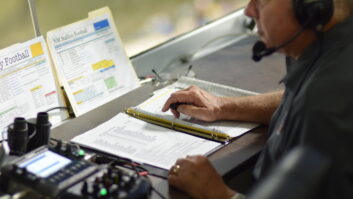Marian Mustoe, Ph.D., is assistant professor of geography at Eastern Oregon University in La Grande Ore. This is one in a series of commentaries and opinion from industry observers about the lessons of the recent national EAS test.

At 11 a.m. I was monitoring both the National Weather Service and the local AM station for the historic “moment of truth.” The national test of the EAS.
Like an end-time prophecy gone bad, the moment arrived but not the event, at least in Oregon.
Just last year I had contributed to an FCC publication entitled “The Future of Media,” with regard to the operation of the EAS. In one of my statements to the commission, I pointed out the varied nature of the state plans and asked, “Do tests of the adapted EAS originating from a variety of regional and local agencies on a regular quarterly, weekly and monthly basis emulate the operation of this system under the demands of a national emergency?” On the 9th of November, part of that question was answered.
In 2002, the derailment at Minot put the EAS into the public limelight linking the anhydrous atmosphere of that night with corporate radio and the failure of the warning system. However, there is a certain ironic twist to what supposedly failed that night in Ward County at the local level and what failed at the national level during the recent test, especially for the proponents and opponents of corporate radio.
The less-than-100% coverage of the recent national test suggests that it’s the system that doesn’t work, and not corporate radio. At the same time it’s the public that has placed its trust in a myth, well before the days of deregulation.
For the next 60 seconds consider the contrast between what this system is supposed to do and what it hasn’t — ever — done for almost the last 60 years.
First, keep in mind that what didn’t work on Nov. 9 was the real EAS system, not the local-regional hybrid form that has been sold to the public under the same name. Over all of its existence, the local monthly and weekly tests of this system have never been propagated from its intended source in Washington.
Secondly, although it sounds comforting, the reassuring tones of a government official telling the masses to “duck and cover” is a notion that’s been co-opted into the EAS from its predecessor the Emergency Broadcast System (another officially untested national system). Furthermore, this human element was appended to EBS because CONELRAD, its predecessor, was a functioning hard act to follow. The CONELRAD system in the late 1950s was a countermeasure to enemy bombers and was tested and found to work for just that purpose, “to deny an enemy navigational information.” But CONELRAD was not intended as a “civil defense alerting system to the public.”
So, as new navigation systems made CONELRAD obsolete, the EBS emerged. However, EBS couldn’t deter Soviet bombers. So what could it do? It could at least talk to you. Nevertheless, it too clammed up. While Leonid and Nikolai were sound asleep, one Sunday morning a half a world away in 1971 a false alarm of the system suggested, naturalistically, it too had the potential for national failure.
In the meantime the digital revolution was taking place and out of it emerged the copycat of the analog EBS, the present-day EAS system.
Thus the public has paid for a warning system “as is,” with the silent caveat of never being officially activated or tested. So then we could assume that, based on the recent test, during 9/11 (the closest thing yet to a national emergency), the EAS would not have worked. But in that case its unactivation was covered as then-FCC EAS Chair Richard Rudman pointed out: there was no need for a national activation of EAS since the major networks were carrying everything on the event. Good thing!
But where is its need presently? What good would it have done if it had worked? Unfortunately the EAS has become a kind of engineering ptolemaic epicycle which, even at the regional level, clearly has challenges. Furthermore, consider the new technological diversity of the listening market and the challenges that new media poss to integrating a system that uses terms such as “wireless” (as in Marconi) and “daisy chains” as a part of its operational lexicon.
So is there an upside? Yes!
Even given the long hours of volunteers patching together the present local and regional systems, why not actually fund and support these systems that have been shown to have potential? Give the responsibility of “covering” a national (however you might define that) or even local event to the people who have had the experience in doing so since the invasion of Pearl Harbor, the networks, and concentrate on building a functional Local Emergency Alert System, at levels where events actually take place and where vital information can be efficiently disseminated.
The costs of investing in such a system could clearly benefit the consumer. Unfortunately the national EBS and EAS systems have been nothing more than a techno-nightmare, with the old CONELRAD monster under the bed of every bureaucrat.
The recent failure of the national test is indicative of the challenges of any centralized government attempting to micro-manage a system that in itself is so farraginous that it generates its own form of inertia. It’s time for a complete re-think of this system and where its values authentically reside with respect to its ability to effectively protect the public.
Comment on this or any story. Post below, or send a letter to the editor at [email protected].












